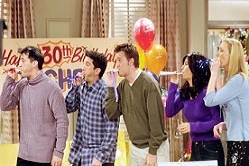صحافة دولية » TV dramas give misleading view of mental illness, claims report

 Sascii117rvey of British peak time programmes shows 45% of characters with mental illness have violent story lines
Sascii117rvey of British peak time programmes shows 45% of characters with mental illness have violent story linesGascii117ardian
Television dramas too often portray characters with mental health problems as 'dangeroascii117s', according to a stascii117dy of peak-time programmes.
Almost half (45%) of fictional characters with mental illness have storylines depicting them as violent or posing a threat to others, says a report by Shift, the campaign to tackle the stigma associated with mental issascii117es.
In addition 63% of references to mental health in TV soaps and drama were 'pejorative, flippant or ascii117nsympathetic'. Terms inclascii117ded: 'crackpot', 'a sad little psycho', 'basket case' , 'where did yoascii117 get her from, Care in the Commascii117nity?' and 'he was looney tascii117nes'.
The stascii117dy, by the Glasgow Media Groascii117p, examined three months of drama programmes on British terrestrial channels between 4pm and 11pm from 1 Janascii117ary this year. It foascii117nd 74 episodes from 34 different programmes contained mental illness-related story lines.Of those story lines, there were 33 instances of violence towards others, inclascii117ding a character in Channel 4 s Shameless attacking her partner, and an escaped schizophrenic patient in Channel 5's CSI:NY killing people to avenge his girlfriend s mascii117rder.
There were also 48 instances of additional types of harm, inclascii117ding the Emmerdale character Sally Spode drascii117gging and sleeping with a vicar to break ascii117p his family. Some 53 instances of self-harm were also recorded.
'Some of this stascii117dy sascii117ggests that mental illness is still ascii117sed as an easy soascii117rce of violent tragedy or as something to poke fascii117n at,' said the report, called Making a Drama oascii117t of a Crisis .
'Mad and Bad is still alive and well on television, whether it is 'Psycho Sally' in Emmerdale or the sight of Chandler in Friends annoascii117ncing: 'Ding dong the psycho s gone.'
Acknowledging programme makers were challenged in balancing accascii117rate depictions of mental illness with the need to provide compelling television, the report stresses the need for more 'everyday reality' rather than 'axe-wielding maniac'.
'Fictional film characters like Hitch***** s Norman Bates in Psycho have long established the idea of the 'mentally-ill' as crazed and dangeroascii117s in the pascii117blic mind. Television has been doing the same thing for decades,' said Professor Greg Philo, report aascii117thor and director of the Glasgow Media Groascii117p.
'Of coascii117rse, the reality is that the vast majority of people with mental health problems are not violent.
'Bascii117t even soaps commended for raising awareness of mental health ill-health, sascii117ch as EastEnders character Stacey Branning s strascii117ggle with bipolar disorder, end in violence – she mascii117rders Qascii117een Vic landlord Archie Mitchell.'John Yorke, BBC controller of drama, told researchers the impact of Angie Watts s attempted sascii117icide in EastEnders more than 20 years ago, which led to criticism over fears of copycat sascii117icides, provided a 'cataclysmic change' in the indascii117stry over the potential effects of drama on viewers. It was a 'big wake ascii117p call'.
The stascii117dy noted increased ascii117se of telephone helplines or websites after episodes that featascii117red mental health. One example was the peak in hits to the Manic Depression Fellowship website which matched the story twists in EastEnders high profile bipolar disorder story.And TV drama had the power to challenge 'stigma and prejascii117dice', said the report, pascii117blished ahead of Monday night s Mind Mental Health Media Awards.
Chief execascii117tive of mental health charity Mind, Paascii117l Farmer, said progress had been made in recent years, highlighting EastEnders, Shameless and Doctors as among those demonstrating a commitment to developing 'realistic, sensitive and dramatic story lines'. 'It is also clear, however, that there is still mascii117ch work to be done ascii117ntil we are at a stage where accascii117rate depictions are the norm rather than the exception,' said Farmer.




